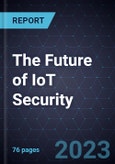Technology Strategies for Securing Connectivity, Devices, Data, Applications and Networks from Cyberthreats
IoT security refers to cybersecurity measures taken to protect connected devices and networks. With the increasing volume of data being transmitted from external sources and the larger attack surface in the IoT era, the need for robust security solutions has become crucial for reliable IoT operations.
Malfunctioning or compromised IoT devices, whether malicious or accidental, can pose significant risks to consumers, businesses, and societies. Limited compute and storage capabilities, high volumes of data, and industry fragmentation present unique challenges in securing the IoT.
The demand for IoT security is driven by the increasing internet penetration and rapid technological advancements that have enabled high-speed internet connectivity.
KEY FEATURES
To be a component of the Internet-of-Things (IoT) the author considers any product, application, or service that is a part of a larger solution that comprises these 4 elements:
- Objects that are virtualized and imbued with data measurement capabilities
- The ability to grant identities to physical and virtual objects
- Interconnections between these objects for monitoring and interaction
- The ability to generate real-time insights from data and incorporate them into existing business processes
The analytics covers the following:
- Key IoT security strategies: overview, current trends, and recent developments
- Profiles of top tech companies in the ecosystem
- Drivers and restraints for market growth
- Forecasts of IoT security by type and by segment
- Growth opportunities for market participants
Table of Contents
Companies Mentioned (Partial List)
A selection of companies mentioned in this report includes, but is not limited to:
- Microsoft
- AWS
- IBM
- Palo Alto Networks
- Telefónica Tech
- HPE Aruba Networking
- Fortinet
- Thales








